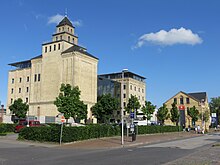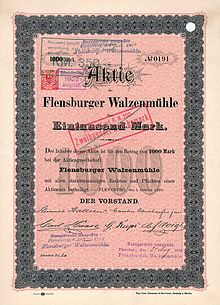Roller mill Flensburg

The Flensburg roller mill ( Danish : Valsemølle ) is a cultural monument in the Neustadt district of Flensburg . The building complex of a former industrial grain mill was built from 1889.
At the time, the construction meant the economic shutdown of numerous windmill operators from the area. In 2005 the city had the building converted into a service center. Now is home to several offices, including the call center of Webhelp Germany GmbH (formerly Perry & Knorr Flensburg GmbH) , as well as a branch of the Nord-Ostsee Sparkasse and a wine merchant (Roberto Gavin Weinkontor) , previously at Ballastkai on Flensburg Harbor had its location , where the clearship building is today. The roller mill is considered a landmark of the new town.
history
prehistory
Before the roller mill was built, Flensburg was a mill town. Over the centuries, 30 windmills and 24 water mills were built, of which, according to a legend, the Blackmöhle is believed to be the oldest mill (cf. Eddeboe ). A wide variety of natural products were ground using wind and water power. For example, on the edge of the Hafenspitze, on the Mühlenstrom, the large royal water mill , which ground grain , had been located for centuries . Also saw mills were apparently among the Flensburger mills. There was even a powder mill . With the advent of industrial mills , which were operated with steam regardless of the weather , the decline of the windmills began. The old, now inflexible and uneconomical mills also disappeared in Flensburg. The Flensburg roller mill is said to have played a part in the disappearance. The royal water mill (1823 *, † 1898) after the owner Nicholas rings also Ringe'sche watermill called, belonged since 1905 the city. In 1919 the mill was destroyed by fire and the last remains of the building were demolished in 1928. Of the numerous conventional mills in Flensburg, only the Bergmühle and the Johannismühle, which is now seriously endangered, survived . Various street names still bear witness to other mills today.
Construction and operation of the roller mill
In 1889, investors founded Flensburger Walzenmühle AG with a share capital of 300,000 marks . In 1890 the planned roller mill was built and put into operation, which at that time consisted of the director's villa, the boiler house and the mill and silo building. The Flensburg architect Alexander Wilhelm Prale was responsible for this first phase of construction in the neo-Gothic style of the Hanover School . In 1891 the first dividend payment was made to the shareholders. 1895 was ground memory for Werftstraße toward and 1904 an intermediate mounting between the director Villa and the boiler house. In 1911 the mill was converted from steam power to electricity. The striking silo tower was not built until 1916/1917 ; at the same time a bagging plant and the drying oven building were built. In 1920, after the referendum , the operators lost suppliers and sales markets in North Schleswig . In 1939/1940 the new silo was built, in 1948 the porter's lodge was built into the old boiler house and in 1948/1949 flour was delivered for blocked Berlin . In 1950 parts of the building were rebuilt and expanded. In addition, the forge was built.
Grain was ground in the industrial mill until 1972. Since the mill only caused losses, production had to be stopped. The building then served as a warehouse for a Rotermund company until 1997 (cf. Beate Uhse AG and Orion ). Since the mill work was still intact, unlike many similar systems, the proposed Monument Protection Authority of the city of Flensburg in 1989 at the State Conservation Office of Schleswig-Holstein in Kiel, the protected status as a cultural monument . As a result, the roller mill was placed under protection and the ensemble was entered in the monument book in the year that operations were closed. In 1999 the monument protection was implemented immediately. Then the roller mill was acquired by the city in 2000 and sold in 2004 to the ArGe roller mill (see working group ) for conversion .
Conversion
The actual conversion process began in 2005. In addition, large parts of the building were demolished and new ones added, which significantly changed the expression. During the demolition process in 2005, the boiler house, the bagging plant, the drying kiln building, the new silo building and the forge were lost. The focus was not on restoring the original state of construction from 1890 or the later from 1917 or on preserving the most important industrial buildings, which should have led to the preservation of the boiler house from 1890 and also called the silo tower into question, as it would have been with other parts was created in 1917. Instead, the roller mill was brought into a clearly recognizable horseshoe or U-shape, a shape it had never possessed before. After these demolition measures , a glass atrium was integrated into the front area of the building complex, bringing the U-shape of the building into a complete square shape. The various building levels were converted into lofts . Penthouses were built in the roof areas . Some of the higher areas of the building now offer a view of the Flensburg harbor . A low, not particularly conspicuous extension connects the villa on the street with the rest of the complex. At the beginning of the redesign project, 12 million euros were estimated for the renovation. The federal government, the state and the city ultimately paid out EUR 4.9 million in funding, as they hoped for positive economic effects.
present
After completion, the office space was rented to various companies.
In the run-up to Christmas there has been an annual one-day Advent market in the Walzenmühle since 2006 , organized by the Lions and Rotary service clubs .
Since July 2007, the Flensburg registry office has been holding weddings in the rooms of the roller mill.
The roller mill is now one of the city's largest industrial monuments. The largest industrial monument in the city of Flensburg, however, is the shipyard's industrial monument, which consists of operational parts of the Flensburger Schiffbau-Gesellschaft and the Flensburger Fahrzeugbau . There is also a small industrial mill in the nearby village of Harrislee . Said Ole Möhl now serves as a cultural institution of the local SPD . There is also a former oil mill in the Johannisviertel , which has also been renovated.
In the future it is planned to demolish the surrounding supermarkets, which characterize the built-up area of the roller mill. The area should serve much more residential purposes and be designed accordingly.
See also
literature
- Broder Schwensen (Ed.): The Flensburg roller mill . Werden und Wandel 1889–2007 (= series of publications by the Society for Flensburg City History . Volume 64 ). Society for Flensburg City History, Flensburg 2007, ISBN 3-925856-55-2 .
Individual evidence
- ↑ Gerhard Nowc: Aerial photo of the Neustadt then and now: When the shipyard was on Werftstrasse. In: Flensburger Tageblatt . July 21, 2012, accessed March 9, 2015 .
- ^ Roberto Gavin Weinkontor. Retrieved March 9, 2015 .
- ↑ Flensburg roller mill. (No longer available online.) Project company ArGe Walzenmühle GmbH & Co. KG, archived from the original on September 22, 2013 ; accessed on March 8, 2015 . Info: The archive link was inserted automatically and has not yet been checked. Please check the original and archive link according to the instructions and then remove this notice.
- ↑ Broder Schwensen (ed.): Die Flensburger Walzenmühle, Werden and Wandel 1989–2007, 2007, pages 40 and 46
- ^ A b Andreas Oeding, Broder Schwensen, Michael Sturm: Flexikon. 725 aha experiences from Flensburg !. Flensburg 2009, article: Roll mill
- ^ For example: Flensburger Norden eV , accessed on: March 9, 2015
- ^ A b Andreas Oeding, Broder Schwensen, Michael Sturm: Flexikon. 725 aha experiences from Flensburg !. Flensburg 2009, article: Mühle
- ^ Vg. Flensburg street names . Society for Flensburg City History, Flensburg 2005, ISBN 3-925856-50-1 , article: Am Lautrupsbach
- ↑ a b See Andreas Oeding, Broder Schwensen, Michael Sturm: Flexikon. 725 aha experiences from Flensburg !. Flensburg 2009, article: Roll mill
- ↑ Cf. City Archives Flensburg : Rings'sche Wassermühle - Mühlengang , accessed on: March 11, 2015
- ↑ Flensburg street names . Society for Flensburg City History, Flensburg 2005, ISBN 3-925856-50-1 , article: Am Mühlenteich
- ↑ See Flensburg street names . Society for Flensburg City History, Flensburg 2005, ISBN 3-925856-50-1 as well as: List of streets and places in Flensburg
- ↑ a b c d e Broder Schwensen (Hrsg.): The Flensburg roller mill. Becoming and Change 1989–2007. 2007, page 54.
- ^ Claus Streichert: Neustadt. Flensburger Norden eV, accessed on March 10, 2015 .
- ↑ Broder Schwensen (ed.): The Flensburg roller mill. Becoming and Change 1989–2007. 2007, page 8.
- ↑ Broder Schwensen (ed.): The Flensburg roller mill. Becoming and Change 1989–2007. 2007, page 40.
- ↑ a b c d e Broder Schwensen (Hrsg.): The Flensburg roller mill. Becoming and Change 1989–2007. 2007, page 8 and page 9.
- ↑ Broder Schwensen (ed.): The Flensburg roller mill. Becoming and Change 1989–2007. 2007, page 40.
- ↑ Broder Schwensen (ed.): The Flensburg roller mill. Becoming and Change 1989–2007. 2007, page 8 f. and page 54.
- ↑ Broder Schwensen (ed.): The Flensburg roller mill. Becoming and Change 1989–2007. 2007, page 41 and page 54.
- ↑ Broder Schwensen (ed.): The Flensburg roller mill. Becoming and Change 1989–2007. 2007, page 41.
- ↑ Broder Schwensen (ed.): The Flensburg roller mill. Becoming and Change 1989–2007. 2007, page 41 and page 55.
- ↑ Broder Schwensen (Ed.): Die Flensburger Walzenmühle, Werden and Wandel 1989–2007, 2007, page 55
- ↑ https://web.archive.org/web/20160304193455/http://walzenmuehle-flensburg.de/assets/images/db_images/db_B_Fl_Avis_220320025.jpg
- ↑ Broder Schwensen (ed.): Die Flensburger Walzenmühle, Werden and Wandel 1989–2007, 2007, page 46
- ↑ Gisela Walter: Advent market roller mill. In: Flensburg Journal. October 30, 2014, accessed March 8, 2015 .
- ^ Holger Ohlsen: Beneficial creativity in the roller mill. In: Flensburger Tageblatt . December 1, 2014, accessed March 9, 2015 .
- ↑ The roller mill. (No longer available online.) In: Getting married in Flensburg and Glücksburg. Inixmedia on behalf of the registry office Flensburg, 2011, archived from the original on March 3, 2016 ; accessed on March 9, 2015 (4th edition). Info: The archive link was inserted automatically and has not yet been checked. Please check the original and archive link according to the instructions and then remove this notice.
- ↑ See Broder Schwensen (Ed.): Die Flensburger Walzenmühle, Werden and Wandel 1989–2007, 2007, page 40
- ^ Info letter - March 2012. WE. SPD local association Harrislee SPD - Kulturschuppen successful for 15 years in Harrislee , p. 1 ff .; accessed on: February 12, 2019
Web links
- Walzenmühle Flensburg Website for the roller mill of the project company ArGe Walzenmühle GmbH & Co. KG
- Perry and Knorr (homepage of by far the largest roller mill company)
Coordinates: 54 ° 47 ′ 48.2 " N , 9 ° 25 ′ 42.4" E



